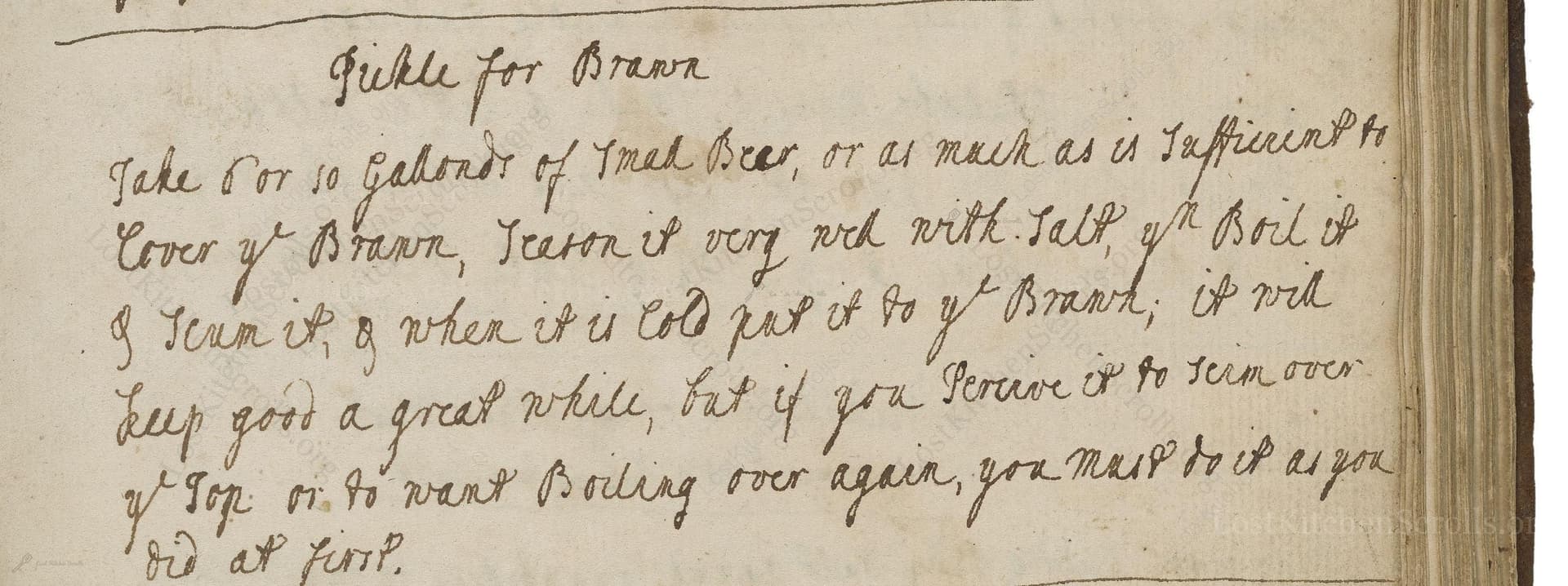Pickle For Brawn
From the treasured pages of Receipt book of Elizabeth Smith
Written by Elizabeth Smith

Pickle For Brawn
"Take 8 or 10 Gallons of Small Beer, or as much as is Sufficient to Cover ye Brawn, Season it very rich with Salt, & Boil it & Scum it, & when it is Cold put it to ye Brawn, it will keep good a great while, but if you Perceive it to seim over ye Top, or to want Boiling over again, you must do it as you did at first."
Note on the Original Text
This recipe is written in the direct, imperative style typical of eighteenth-century manuscripts: it minimizes precise measurements and expects the cook to use their judgment ('Season it very rich with Salt'). Spelling variants, like 'ye' for 'the' and 'scum' as 'scum' or 'scum it', are typical of the time. The recipe presumes familiarity with domestic processes such as boiling and scumming liquids, and with storing food in brine. Instructions to 'boil it & scum it' and 'if you Perceive it to seim over ye Top… boil it over again' rely on prior knowledge rather than detailed, stepwise guidance.

Title
Receipt book of Elizabeth Smith (1775)
You can also click the book image above to peruse the original tome
Writer
Elizabeth Smith
Era
1775
Publisher
Unknown
Background
Step into the refined kitchens of the late 18th century with Elizabeth Smith, whose culinary wisdom offers a charming taste of Georgian elegance and time-honored recipes to delight any palate.
Kindly made available by
Folger Shakespeare Library
This recipe comes from the mid- to late-eighteenth century, specifically from the manuscript of Elizabeth Smith, who was active between 1749 and 1800. During this period, small beer was a household staple—less alcoholic than regular beer and commonly used in cooking or as a thirst-quencher, even for children. Brawn, a form of head cheese, was a celebratory winter dish, especially around Christmas. Preserving it in beer and salt brine allowed it to be kept for weeks before the advent of reliable refrigeration. Recipes like this one reflect the practical, seasonal approach to food preservation and the resourcefulness of early modern kitchens.

In the 18th century, this recipe would have been made using a large copper or iron boiling pot for creating the brine. Wooden tubs or stoneware crocks were used to store the brawn under pickle, often with a wooden lid and a clean stone or hammered pewter plate as a weight to ensure the meat remained submerged. Simple skimmers—a flat, perforated metal disc with a handle—were used to remove scum from boiling liquids. Boiling was done over an open hearth or cast-iron range.
Prep Time
30 mins
Cook Time
30 mins
Servings
20
We've done our best to adapt this historical recipe for modern kitchens, but some details may still need refinement. We warmly welcome feedback from fellow cooks and culinary historians — your insights support the entire community!
Ingredients
- 9–10.5 gallons of small beer (substitute: non-alcoholic pale ale, mild lager, or very weak beer, 2–3% ABV or less)
- 2.5–3.5 lbs salt (approximately 10–14 oz per 2.5 gallons of liquid)
- Cooked brawn (traditionally, head cheese or boiled pork head, amount as needed for vessel)
- Water (only if needed to top up liquid)
Instructions
- To make a pickle for brawn using this eighteenth-century method, begin by taking 9 to 10.5 gallons of small beer (a lightly alcoholic, low-strength beer, now easily substituted with a non-alcoholic pale ale or even a very mild lager).
- Pour enough beer into a large, non-reactive tub or pot so that it will cover the pieces of cooked brawn (usually pork head or similar cut).
- Add a generous amount of salt to the beer—approximately 10 to 14 ounces per 2.5 gallons—to make it 'very rich' with salt.
- Bring the mixture to a boil, skimming off any foam or impurities as they rise.
- Once all the foam is gone, remove from heat and allow to cool completely.
- When the brine is fully cold, place the cooked brawn in the vessel and pour the brine over it, ensuring the meat is completely submerged.
- Store cool.
- If you notice any scum or fermentation ('seim') on top of the liquid or suspect spoilage, remove the meat, bring the liquid to a boil again with further skimming, cool completely, and immerse the brawn once more.
- This pickle method will preserve the brawn for several weeks if kept cool.
Estimated Calories
350 per serving
Cooking Estimates
Preparing this pickle for brawn takes about 30 minutes to gather ingredients, measure salt, and handle the cooked meat. Boiling the brine usually takes another 30 minutes, including skimming foam. The brine then needs 2–3 hours to cool fully before you can add the meat. Each serving has about 350 calories, since brawn is mostly lean pork with some fat and the brine does not add significant calories.
As noted above, we have made our best effort to translate and adapt this historical recipe for modern kitchens, taking into account ingredients nowadays, cooking techniques, measurements, and so on. However, historical recipes often contain assumptions that require interpretation.
We'd love for anyone to help improve these adaptations. Community contributions are highly welcome. If you have suggestions, corrections, or cooking tips based on your experience with this recipe, please share them below.
Join the Discussion
Rate This Recipe
Dietary Preference
Main Ingredients
Culinary Technique
Occasions

Den Bockfisch In Einer Fleisch Suppen Zu Kochen
This recipe hails from a German manuscript cookbook compiled in 1696, a time whe...

Die Grieß Nudlen Zumachen
This recipe comes from a rather mysterious manuscript cookbook, penned anonymous...

Ein Boudain
This recipe comes from an anonymous German-language manuscript cookbook from 169...

Ein Gesaltzen Citroni
This recipe, dating from 1696, comes from an extensive anonymous German cookbook...
Browse our complete collection of time-honored recipes



